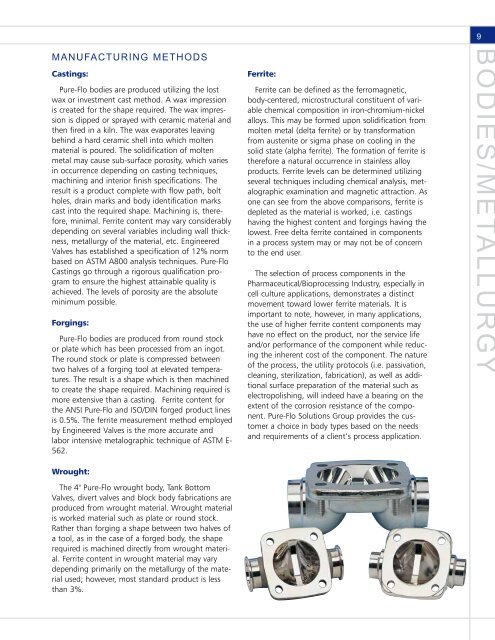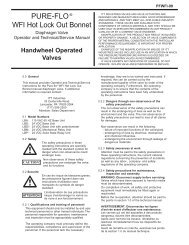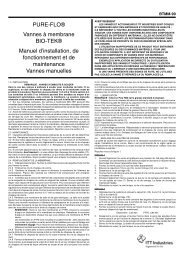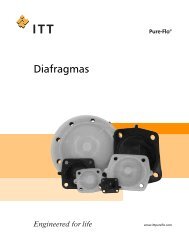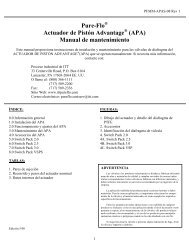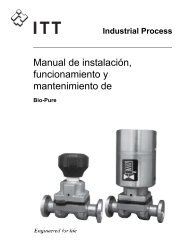You also want an ePaper? Increase the reach of your titles
YUMPU automatically turns print PDFs into web optimized ePapers that Google loves.
MANUFACTURING METHODS<br />
Castings:<br />
<strong>Pure</strong>-Flo bodies are produced utilizing the lost<br />
wax or investment cast method. A wax impression<br />
is created for the shape required. The wax impression<br />
is dipped or sprayed with ceramic material and<br />
then fired in a kiln. The wax evaporates leaving<br />
behind a hard ceramic shell into which molten<br />
material is poured. The solidification of molten<br />
metal may cause sub-surface porosity, which varies<br />
in occurrence depending on casting techniques,<br />
machining and interior finish specifications. The<br />
result is a product complete with flow path, bolt<br />
holes, drain marks and body identification marks<br />
cast into the required shape. Machining is, therefore,<br />
minimal. Ferrite content may vary considerably<br />
depending on several variables including wall thickness,<br />
metallurgy of the material, etc. Engineered<br />
Valves has established a specification of 12% norm<br />
based on ASTM A800 analysis techniques. <strong>Pure</strong>-Flo<br />
Castings go through a rigorous qualification program<br />
to ensure the highest attainable quality is<br />
achieved. The levels of porosity are the absolute<br />
minimum possible.<br />
Forgings:<br />
<strong>Pure</strong>-Flo bodies are produced from round stock<br />
or plate which has been processed from an ingot.<br />
The round stock or plate is compressed between<br />
two halves of a forging tool at elevated temperatures.<br />
The result is a shape which is then machined<br />
to create the shape required. Machining required is<br />
more extensive than a casting. Ferrite content for<br />
the ANSI <strong>Pure</strong>-Flo and ISO/DIN forged product lines<br />
is 0.5%. The ferrite measurement method employed<br />
by Engineered Valves is the more accurate and<br />
labor intensive metalographic technique of ASTM E-<br />
562.<br />
Wrought:<br />
The 4" <strong>Pure</strong>-Flo wrought body, Tank Bottom<br />
Valves, divert valves and block body fabrications are<br />
produced from wrought material. Wrought material<br />
is worked material such as plate or round stock.<br />
Rather than forging a shape between two halves of<br />
a tool, as in the case of a forged body, the shape<br />
required is machined directly from wrought material.<br />
Ferrite content in wrought material may vary<br />
depending primarily on the metallurgy of the material<br />
used; however, most standard product is less<br />
than 3%.<br />
Ferrite:<br />
Ferrite can be defined as the ferromagnetic,<br />
body-centered, microstructural constituent of variable<br />
chemical composition in iron-chromium-nickel<br />
alloys. This may be formed upon solidification from<br />
molten metal (delta ferrite) or by transformation<br />
from austenite or sigma phase on cooling in the<br />
solid state (alpha ferrite). The formation of ferrite is<br />
therefore a natural occurrence in stainless alloy<br />
products. Ferrite levels can be determined utilizing<br />
several techniques including chemical analysis, metalographic<br />
examination and magnetic attraction. As<br />
one can see from the above comparisons, ferrite is<br />
depleted as the material is worked, i.e. castings<br />
having the highest content and forgings having the<br />
lowest. Free delta ferrite contained in components<br />
in a process system may or may not be of concern<br />
to the end user.<br />
The selection of process components in the<br />
Pharmaceutical/Bioprocessing Industry, especially in<br />
cell culture applications, demonstrates a distinct<br />
movement toward lower ferrite materials. It is<br />
important to note, however, in many applications,<br />
the use of higher ferrite content components may<br />
have no effect on the product, nor the service life<br />
and/or performance of the component while reducing<br />
the inherent cost of the component. The nature<br />
of the process, the utility protocols (i.e. passivation,<br />
cleaning, sterilization, fabrication), as well as additional<br />
surface preparation of the material such as<br />
electropolishing, will indeed have a bearing on the<br />
extent of the corrosion resistance of the component.<br />
<strong>Pure</strong>-Flo Solutions Group provides the customer<br />
a choice in body types based on the needs<br />
and requirements of a client’s process application.<br />
9<br />
BODIES/METALLURGY


